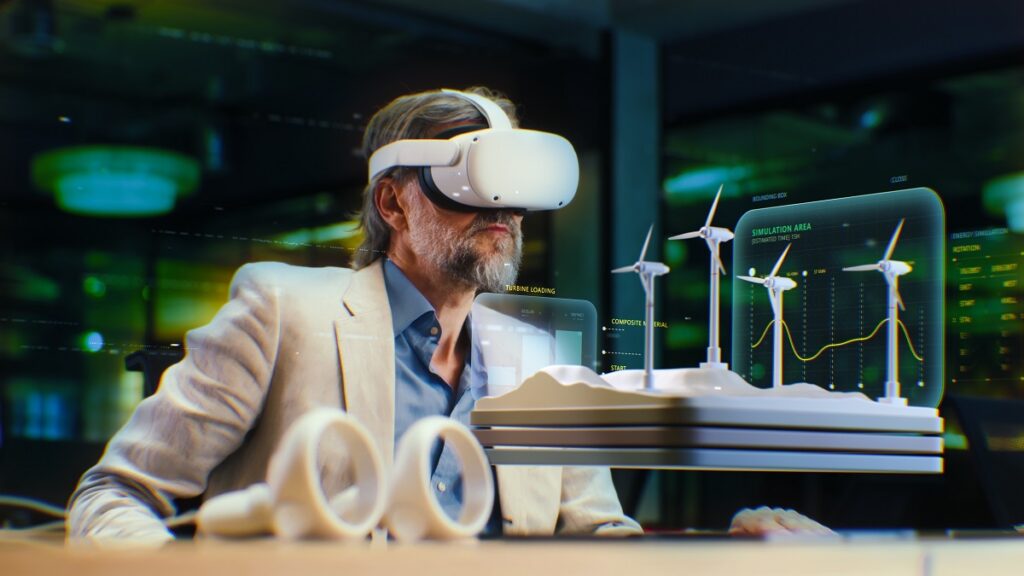The Metaverse and Extended Reality XR
The metaverse has evolved beyond a buzzword into a tangible digital universe, offering immersive environments where individuals can work, play, meet, and communicate. At the heart of the metaverse is extended reality (XR), a technology that includes virtual reality (VR) and augmented reality (AR), enabling users to engage in digital spaces in a way that is more immersive than ever before. The combination of VR and AR technologies powers the metaverse, transforming how we experience everything from entertainment to business. Here’s a closer look at the trends and applications shaping the future of the metaverse and XR.

Trends in the Metaverse
1. Virtual Workspaces:
As remote work becomes more popular, companies are turning to VR environments to facilitate more engaging and collaborative remote work experiences. Virtual workspaces allow employees to interact with each other in real time in immersive, 3D environments, transcending the limitations of traditional video calls. This shift not only increases productivity but also fosters a sense of presence and connection that was previously unavailable in virtual meetings.
2. Digital Real Estate:
In the virtual world, digital real estate is becoming an increasingly lucrative investment. Virtual spaces — from entire cities to individual plots of land — are being bought and sold on platforms like Decentraland and The Sandbox. These digital properties are used for a variety of purposes, including virtual stores, art galleries, event spaces, and even offices. As more businesses and individuals flock to the metaverse, demand for digital real estate is expected to continue to grow, mirroring the boom in real-world real estate..
3. Gaming Evolution:
Gaming has long been a major driver of the metaverse, and immersive gaming experiences are fueling its expansion. In the metaverse, players can engage in virtual worlds that offer rich, interactive gameplay with a high level of immersion. Virtual items and avatars are becoming increasingly valuable, and in-game economies are developing in substantial markets. The integration of VR and AR in gaming is enabling more realistic experiences, where players can physically move into the game environment, further blurring the lines between the virtual and real worlds.
XR Applications
1. Education:
Extended Reality (XR) is revolutionizing the education sector, providing immersive learning experiences that were previously unimaginable. AR-enabled lessons allow students to interact with digital objects in the real world, increasing engagement and understanding. For example, anatomy students can explore 3D models of the human body, while history students can experience historical events firsthand through VR simulations. This learning method helps students retain information better and stimulates creativity.
2. Healthcare:
XR technologies are transforming healthcare by providing valuable tools for both medical training and patient treatment. VR simulations are used in medical schools to train students to perform surgeries, treat conditions, and diagnose conditions in a safe, controlled environment. Additionally, VR therapy is being used to treat patients with mental health conditions such as PTSD, anxiety, and phobias, offering immersive and interactive ways to manage symptoms and aid in recovery. The use of XR in healthcare is expanding to include telemedicine and virtual rehabilitation programs, increasing access to care.
3. Retail:
In the retail sector, XR technologies are changing how consumers shop by enabling virtual try-on experiences. Augmented Reality (AR) apps allow customers to try on clothes, accessories, or even makeup virtually before making a purchase. This not only improves the online shopping experience but also reduces the likelihood of returns, as customers can better visualize how products will look in real life. In addition, virtual stores are emerging within the metaverse, where users can shop in fully immersive 3D environments, blurring the line between physical and virtual retail.
Future Scope of the Metaverse and XR
The Metaverse and XR technologies are poised to redefine how we interact with the digital world. As XR devices become more affordable and accessible, the Metaverse will permeate every aspect of everyday life—social interactions, commerce, education, entertainment, and beyond. Virtual experiences will no longer be limited to entertainment or business applications. They will permeate all industries, offering new ways to engage with information, products, and services.
In the coming years, the Metaverse will likely become an integral part of people’s daily lives, enabling new forms of work, socialization, and creative expression. As the technology matures, we can expect more advanced applications of XR in areas such as tourism, real estate, and even space exploration. The future of the Metaverse is limitless, with the potential to reshape our digital interactions and how we experience the world.



